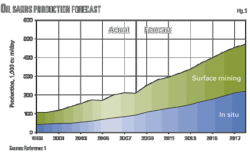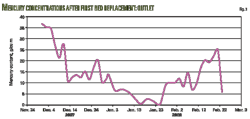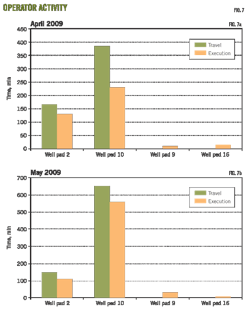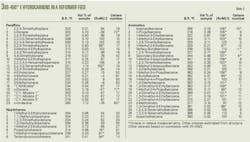Based on a presentation to Deep Gulf, Galveston, Tex., Dec. 3, 2009.
Operating companies need to address many factors in designing subsea metering installations. Among these are five major ones discussed in this article.
From 2003 to 2006, operators in the Gulf of Mexico installed a large number of subsea multiphase flow and wet-gas meters for allocating individual flow streams from many different leases. During the last 5 years, many of these MPFM and wet-gas meter applications have been successful; however, some operations and installations have had problems that could have been avoided.1-3
Critical to a successful application is an understanding of the complete operation and installation needs for each different type of subsea meter.4
Meter challenges
The most obvious challenge with subsea metering is the lack of direct access to the meter, making it physically difficult to open a meter to see what potential damage or build up has occurred.5 Other challenges with these meters include:
• Lack of a good reference vessel for verifying meter performance.
• Difficulty in replacing failed components such as differential pressure and temperature sensors.
• Difficulty in obtaining sampling fluids for in situ meter calibration.
In a sense, the meters are like sending probes into space knowing you will never get another chance to see them after their installation because most meters are not retrieved for service or replacement.2
The five major design factors discussed in the article that one needs to consider are:
1. Electronics and heat cycles.
2. Meter calibration and post-installation tuning: in situ density and fluid properties.
3. Fiber-optic data transmission, control, and baud rates.
4. 10,000 to 15,000-psi pressure containment and risk.
5. Maintenance and intervention.
Electronics, heat cycles
All of today's MPFMs use a data-acquisition flow computer and some minor integrated circuitry and power modules.
The subsea meter electronics have a design that handles a high-heat cycle during the welding of the meter to a jumper. The electronics typically cannot handle several heat cycles during which welding temperatures cause the material temperature to rise from ambient conditions to well above 300° F.
Regarding welding, the critical issue is grounding out the electronics if the meter has retrievable electronics. More than one subsea MPFM has failed because of overloading the electronics in the flow computer because of a poor or improper grounding of the meter during welding.
In meters without retrievable electronics, one needs to ground the body to ensure no charge builds up in the steel and arcs to an electronic component.
For new meter designs, vendors may have the flexibility to weld the blind tee on the inlet and a discharge piece on the outlet prior to installing any electronics. This prevents the adverse effect of heat from the welding affecting the instruments. In this case when welding the meter onto a jumper, they just need to ground the whole meter.
All metering vendors will have their personnel on site to supervise welding operations. It is also a good idea for the vendor to have a meter representative on site during all site installation tests, load-outs to the dock, and field installation because most meter vendors will not warrant the meter if their representative is not present during these operations.
If early in the engineering process there is a suspected issue because of high temperature and pressure limitations, it is recommended to perform a finite element analysis on heat and pressure transfers within the meter design. This will provide a better understanding on whether welding, operating temperatures, and pressure along with pressure testing are critical issues.
Today's vendors strive to build superior products that will last a long time in subsea conditions. As such, they will offer solutions that have been proven, redesigned, and retested since the early failures in the technology.
Meter calibration
The MPFM design allows operators to measure the density and velocity of fluid flow in a pipe. Because of multiple fluid phases, the determination of the mass flow rate of each phase requires knowledge of the mixture density within the pipe and the velocity of each phase.7
In addition, the MPFM operates at line conditions; therefore, flow calculations are made at the line pressure and temperature. The fluid will expand and shrink as it goes through the production process, therefore understanding the fluid properties is critical for determining the flow rates at standard conditions.
For topsides installations, several different methods can capture representative samples for determining fluid properties.For subsea installations, however, sampling becomes difficult.
Each subsea development with a MPFM needs to have a plan for taking samples used for determining fluid properties.8 One solution is to flow the well to a surface facility test vessel that captures samples. The problem with this method is that the fluid has gone through a phase change, so that density measurements at this point are not representative of the meter's flowing conditions.9
The solution in this case is to perform a recombination pressure-volume-temperature study from the separator samples and use a restored reservoir fluid study to determine the density of the fluid phases at the pressure and temperature conditions of the subsea meter.
Downhole sampling is another method for capturing samples. Usually, this gives the most representative sample. But for a subsea well, this method may be impossible without the use of an expensive drilling rig or intervention vessel.10
Ideally, one would like to use a remote-operated vehicle system and a sampling port at the subsea wellhead just upstream of the meter to capture representative samples from each well being metered (Fig. 1). The ROV could then return the samples to surface for a PVT analysis used for calibrating the meter and determining fluid properties.11 Efforts ongoing within the DeepStar and Research Partnership to Secure Energy for America organizations are working to develop industry standards for subsea sampling techniques.
Improper density measurements and incorrect fluid property tables programmed into a multiphase meter will yield large errors in the overall measurement giving potential allocation errors that can be costly.4
One meter installation for example, underwent extreme scrutiny and review when incorrect water density measurements were left in the MPFM as a well continued to produce greater quantities of water. This resulted in higher oil readings and lower water readings and accounted for a large reallocation effort for 6 months of production. The cost to the partners involved was high because the reallocation involved hundreds of thousands of barrels of oil produced during 6 months. This was a multimillion dollar correction.
Fiber optics
Communication to and from a subsea MPFM is critical to the success of its operation. Today's subsea MPFMs provide high rates of data flow that offer a level of dynamic measurement unlike any other device in an installation. Thus, their importance and interest to reservoir and production engineers.
One major challenge with subsea MPFMs today is the limited amount of transmission speed allowed in a conventional umbilical and subsea electronic module.
In the past, MPFM vendors were limited to a baud rate of 1,200-2,400 bits/sec. These meters can function at these levels, but the amount of data one receives is limited. If troubleshooting is needed, the meter vendor will want all the data from these meters and a low baud rate will prevent access to all this data. This can be a major problem for controlling the functions of a MPFM.
In addition, most meters on the market today can record raw data and allow for a post process with updated references if required. This helps when operators leave meters alone for a long time and when produced fluid properties change over time without updates of the proper references. In this case, if one can access all data, it is possible to take samples, update references into the meter, and reprocess the entire history of recorded data through the meter calculations using the updated references.
With limited baud-rate transmission capacity, one cannot perform post processing or intensive troubleshooting should problems with the meter arise.
The use of fiber optics within the umbilical provides a solution for gaining access to all data from a meter. MPFMs have typical baud operating rates of 38,500 bits/sec and fiber optic transmission lines will allow more than sufficient data capacity given these inputs.
Pressure containment
One should do a formal risk assessment in the early engineering design phase for using a subsea MPFM or wet-gas meter.12 The first priority for a MPFM is for keeping sea water out of the subsea production system. Then it needs to maintain the pressure and temperature conditions it will face. This leads to look at pressure containment and risk as the designer tries and relates the two.
Most subsea MPFMs are supplied with a standard pressure rating between 7,500 and 10,000 psig. For many deepwater applications, the requirements for higher pressure ratings have pushed the limits of the technology.
Until 2009, no vendor had access to differential-pressure transmitters with higher pressure ratings than 12,500 psig. If the installation needed a differential-pressure measurement qualified up to 15,000 psig, one would take two 15,000-psi rated absolute pressure transmitters and apply a differential reading to them by taking their independent measurements.
Today, Fuji now offers a 15,000-psig differential-pressure transmitter. This will help meter vendors with the 15,000 psi pressure limitation they have struggled with.
A recent installation in the Gulf of Mexico witnessed the failure of a differential-pressure transmitter on a newly installed meter during the commissioning phase. This happened during a hydrostatic pressure test of the final assembled subsea production system. An isolation valve closed in a feedback loop and the test placed 15,000 psig on a newly installed multiphase flowmeter with a 12,500-psig rating. The differential-pressure sensor failed, leaving the meter inoperable, before having a chance to measure first oil.
Later it was determined that if the operator had a representative from the vendor on site, the event could have been better understood and avoided. The operator was being represented by a third party consultant who refused to use a representative from the vendor during the commissioning of the meter.
The industry has many different types of reliability and risk techniques that it can use including:
• Failure mode and effect analysis (FMEA).
• Failure mode and effect criticality analysis (FMECA),
• Layer of protection analysis (LOPA).
• Reliability, availability, and maintainability (RAM) analysis.
A recent Det Norske Veritas study on multiphase flowmetering considers failure "as the termination of the ability of an item to perform the intended (specified) function."12
To understand when a failure may occur in the meter or the system, one first must clearly define the function of the meter within the system. Depending on what the meter is intended to measure will help define the function of risk. Two like meters used in different operations could then have different reliabilities to their function.
This is an important aspect in ultradeepwater applications in which stressful environmental factors such as operating pressure and temperature or variation in the characterization of the measured fluid demand high levels of endurance.13
The industry has used many different types of risk matrices over the years for identifying acceptable risk levels for designing pressure ratings within piping systems, which include spools and valves fitted into those pipes. They help to identify the risk level based on the likelihood of failure and on the severity of the consequence.
Some operators may have their own risk assessment method, but most popular methods derive from the space industry, which is relevant to the subsea industry due to remote locations and level of importance for protecting the environment and marine life surrounding the installations. The risk is typically categorized with a matrix similar that shown in Fig. 2.
After the assessment of the risk in terms of frequency of undesirable events and consequences (in this particular context associated with our inability to measure multiphase production and allocate the production back to the well), it is necessary to have a reference against what this risk can be compared to.12
One should set up this reference, referred to as risk acceptance criteria, before doing a risk assessment. The reference must reflect legal requirements or requirements of the company in terms of:
• What consequence does the company want to measure?
• How will it measure the consequence?
• What level of risk will the company accept?
• What level of reliability or availability is acceptable?
To help define those requirements further, a suggested priority scheme for data sources may be the following:
• Equipment's own history files and records of performance/nonconformance.
• Records of similar equipment and similar environment.
• Generic (commercial) databases.
• Manufacturer tests.
• Engineering judgment.
As an example, what is the likelihood that a severe, major, or catastrophic event could occur implementing a new technology without the supervision of the vendor? Plausible at the very least and therefore, one should make sure that a qualified person oversees the operation or simply make sure that a vendor representative is present during meter installation and commissioning.
Maintenance
Multiphase flowmeters are not an install and forget type of equipment. Proper performance monitoring and meter management will benefit the operator by gaining the most dynamic knowledge of the ongoing production. Paying attention to the detail of an operating meter puts the operator in a position to understand how a well is producing.9 Some key benefits in doing this are:
• Improved well diagnostics and better flowline monitoring.
• Increased well testing efficiency.
• Continuous measurement and uninterrupted flow.
• Fewer well test related shut-ins.
• Less deferred production.
Engineers must design the MPFM installation so that it integrates into the production system. They should do this in the early design phase. The design of the system often dictates how a meter will fit into a subsea production system.14
If a subsea tree design does not include a retrievable choke bridge where a meter could be installed on (Fig. 3), an engineer may have to install a meter welded into a well jumper. This type of meter is retrieved rarely.
A retrievable meter greatly enhances successful intervention on the MPFM, should the need occur (Fig.4).
A meter welded into a jumper provides no easy solution for retrieving the meter. In all the years this technology has been in subsea production systems throughout the world, operators typically do not pull a jumper to retrieve a meter for repair.
Consequently, it is imperative to test all meter functions and connections several times and include the service vendors' representative when performing tests or making connections. Their day rate is a small price to pay, considering the option to not have them present.
Not involving a service vendor in the field installation has often led to performing an improper procedure or function, thus rendering an expensive subsea component critical to allocation metering, useless.
Fig. 5 shows a subsea wet-gas meter installed on a well jumper.
In many applications, a failed meter remains in place and never receives any further attention. This is due to the fact that pulling jumpers requires heavy lift intervention vessels and many issues may arise from pulling jumpers.
For example, the process of restabbing the jumper may become impossible due to shifting subsea production equipment on the seafloor.
Retrievable electronics (Fig. 6) is a solution that offers more flexibility for intervention because many subsea MPFMs problems are due to data acquisition flow computers and the power module within the electronics section of the meter.
An intervention with an ROV that can pull all or part of the troubled equipment is best. Retrievable meters will require more capital expenditures, but less operating costs should it require retrieving.
Another flexible meter installation design is the placing of a fully retrievable meter on a manifold tied into a well through a flowline jumper (Fig. 7).
Framo Engineering offers a fully retrievable MPFM that can be placed at many different points within the subsea production system. One can retrieve it only or within a section of subsea equipment.15
Recommendations
An important message is that more work up front in the design and engineering phase of a project will assure a selected multiphase flowmeter will perform properly and is integrated properly into the subsea system so that it will require less intervention.
These challenges should be seen as opportunities to improve well diagnostics and increase the understanding of well performance to maintain and improve production.
In addition, it is important to keep the vendor involved through the entire process of engineering, development, installation, commissioning, and operations for the life of the project.
The industry has used MPFMs for more than 10 years, and the estimate is that about 3,000 installations exist in the world, including topside, subsea, onshore, and offshore. They have functioned under tough conditions and with many different flow regimes and flow conditions.
Those vendors still in business today should be considered for any well testing and well monitoring needs operators may have. Using multiphase flowmeters will provide operators with the most dynamic measurement of the producing wells, giving a clear picture of what is happening with their production.16-18
The operation of MPFMs is manageable and can be easily dealt with, but companies need to include vendors in the process and engineering companies need to better understand the operating requirements of the meters to better design and plan for their use.
Acknowledgment
The author thanks Neal Prescott, director of technology, Fluor Corp., Sugar Land, Tex., for his contributions to the support of this article.
References
1. Tyssen, I. "Roxar Subsea Wetgas Meters," INTSOK, Nov. 12, 2009.
2. Kevin, K., "Operating Experiences for the World's First Commercially Installed Multiphase Meters in the Liverpool Bay Field," IBC conference on Multiphase Flowmetering, Aberdeen, Feb. 22-23, 1999.
3. Kennedy, A., and Simm, I., "Use of a Subsea Multiphase Flowmeter in the West Brac/Sedgwick Joint Development," 16th International North Sea Measurement Workshop, Glasgow, Oct. 22, 1998.
4. Tyrrell, C., "Subsea MPFM - Implementation and Lessons Learned," The Americas Workshop, The Woodlands, Tex., Feb. 3-5, 2009.
5. Tyrrell, C., and Joshi, N., "Maintenance and Surveillance of Multiphase Flowmeters," The Americas Workshop, The Woodlands, Tex., Feb. 3-5, 2009.
6. Miller. R., Flow Measurement Engineering Handbook, 3rd Edition, McGraw Hill, New York, 1996.
7. Atkinson, D.I., Berard, M., and Segeral, G., "Qualification of a Nonintrusive Multiphase Flowmeter in Viscous Flow," Paper No. SPE 63118, SPE ATCE, Dallas, Oct. 1-4, 2000.
8. Tyrrell, C., and Joshi, N., "The Role of Subsea Sampling in Multiphase Metering," The Americas Workshop, The Woodlands, Tex., Feb. 3-5, 2009.
9. Mus, E.A., Toskey, E.D., and Bascoul, S.J.F., "Added Value of a Multiphase Flowmeter in Exploration Well Testing," Paper No., OTC 13146, OTC, Houston, Apr. 20-May 3, 2001.
10. Vincent, V., "Multiphase Metering," E&P Magazine, Feb. 1, 2009.
11. Improved Production Sampling using Framo Multiphase Flowmeter, Technical Bulletin, Framo Engineering, October 1999.
12. Deepstar VIII Reliability and Risk Analysis of Multiphase Flowmetering—Summary Report, DSVIII CTR 8302-2, DNV, December 2007.
13. Letton, W., Svaeren, J., and Conort, G., "Topside and Subsea Experience with Multiphase flowmeter," Paper No. SPE 38783, SPE ATCE, San Antonio, Oct. 5-6, 1997.
14. Larson, T.A., "Operational Experience and Utilization of the Data From the Subsea Multiphase Flowmeter in the West Brae Field," 18th North Sea Flow Measurement Workshop, Gleneagles, UK, Oct. 24-27, 2000.
15. A Framo Subsea Multiphase Flowmeter has been in successful operation since November 2000 at the Keith field in the North Sea, Technical bulletin, Framo Engineering, February 2003.
16. Grose, T.D., "The use of Multiphase Meters in Reservoir Surveillance within BP ETAP," IBC Conference on Multiphase Flowmetering, Aberdeen, Feb. 22-23, 1999.
17. "Multiphase Flowmeters: A New Way to Test Wells in Production," Hart First Look, September 1999.
18. Mehdizadeh, P., "Multiphase Meters," Petroleum Engineer International, May 1998, pp. 63-70.
The author
More Oil & Gas Journal Current Issue Articles
More Oil & Gas Journal Archives Issue Articles
View Oil and Gas Articles on PennEnergy.com







